Antibody data
- Antibody Data
- Antigen structure
- References [65]
- Comments [0]
- Validations
- Immunocytochemistry [11]
- Immunoprecipitation [1]
- Immunohistochemistry [2]
- Other assay [23]
Submit
Validation data
Reference
Comment
Report error
- Product number
- MA3-027 - Provider product page

- Provider
- Invitrogen Antibodies
- Product name
- Calnexin Monoclonal Antibody (AF18)
- Antibody type
- Monoclonal
- Antigen
- Other
- Description
- MA3-027 detects calnexin from human and mouse tissues. MA3-027 has been successfully used in Western blot, immunocytochemistry, immunofluorescence and immunoprecipitation protocols. By Western blot, this antibody detects calnexin in human liver, skin, adrenal gland, heart, colon, testes and ovary extracts. This antibody is not recommended for human kidney or mouse liver lysates in Western blot applications. The predicted molecular weight of this antibody is ~67kDa; however, it may run on SDS-PAGE as an ~90kDA protein. This is due mainly to negative charges at the C-terminus of the protein, which effects the SDS binding to the molecules and consequently its SDS-PAGE mobility. Immunocytochemical staining of calnexin in Huh-7 cells with MA3-027 yields a pattern consistent with specific endoplasmic reticulum staining. The MA3-027 antigen is Focus human hepatoma cell lysate.
- Reactivity
- Human, Mouse
- Host
- Mouse
- Isotype
- IgG
- Antibody clone number
- AF18
- Vial size
- 100 μL
- Concentration
- 1 mg/mL
- Storage
- -20°C, Avoid Freeze/Thaw Cycles
Submitted references Heme oxygenase-2 (HO-2) binds and buffers labile ferric heme in human embryonic kidney cells.
Anti-Human CD9 Fab Fragment Antibody Blocks the Extracellular Vesicle-Mediated Increase in Malignancy of Colon Cancer Cells.
Muscle cells of sporadic amyotrophic lateral sclerosis patients secrete neurotoxic vesicles.
Physiactisome: A New Nanovesicle Drug Containing Heat Shock Protein 60 for Treating Muscle Wasting and Cachexia.
Molecular Characterization of an Aquaporin-2 Mutation Causing Nephrogenic Diabetes Insipidus.
The Secreted Protein C10orf118 Is a New Regulator of Hyaluronan Synthesis Involved in Tumour-Stroma Cross-Talk.
Novel missense mutations in PTCHD1 alter its plasma membrane subcellular localization and cause intellectual disability and autism spectrum disorder.
Effects of ER-resident and secreted AGR2 on cell proliferation, migration, invasion, and survival in PANC-1 pancreatic cancer cells.
Proteomic Analysis of Circulating Extracellular Vesicles Identifies Potential Biomarkers for Lymph Node Metastasis in Oral Tongue Squamous Cell Carcinoma.
Chikungunya virus antagonizes cGAS-STING mediated type-I interferon responses by degrading cGAS.
Mechanisms underlying the predictive power of high skeletal muscle uptake of FDG in amyotrophic lateral sclerosis.
Detection of Viral RNA Fragments in Human iPSC-Cardiomyocytes following Treatment with Extracellular Vesicles from SARS-CoV-2 Coding-Sequence-Overexpressing Lung Epithelial Cells.
Class IA PI3Ks regulate subcellular and functional dynamics of IDO1.
CCDC170 affects breast cancer apoptosis through IRE1 pathway.
Heme oxygenase-2 is post-translationally regulated by heme occupancy in the catalytic site.
Engagement of people with multiple sclerosis to enhance research into the physiological effect of hyperbaric oxygen therapy.
Neuronal life or death linked to depression treatment: the interplay between drugs and their stress-related outcomes relate to single or combined drug therapies.
Selective inhibition of N-linked glycosylation impairs receptor tyrosine kinase processing.
Allicin disrupts cardiac Cav1.2 channels via trafficking.
Extramitochondrial energy production in platelets.
Alternative splicing variant of RHBDD2 is associated with cell stress response and breast cancer progression.
Surf4 (Erv29p) binds amino-terminal tripeptide motifs of soluble cargo proteins with different affinities, enabling prioritization of their exit from the endoplasmic reticulum.
A conserved role for the ESCRT membrane budding complex in LINE retrotransposition.
Endophilin B2 facilitates endosome maturation in response to growth factor stimulation, autophagy induction, and influenza A virus infection.
A unique deubiquitinase that deconjugates phosphoribosyl-linked protein ubiquitination.
cTAGE5 deletion in pancreatic β cells impairs proinsulin trafficking and insulin biogenesis in mice.
Function of inhibitor of Bruton's tyrosine kinase isoform α (IBTKα) in nonalcoholic steatohepatitis links autophagy and the unfolded protein response.
RAB2A controls MT1-MMP endocytic and E-cadherin polarized Golgi trafficking to promote invasive breast cancer programs.
The anti-tumor drug 2-hydroxyoleic acid (Minerval) stimulates signaling and retrograde transport.
Effects of an In-Frame Deletion of the 6k Gene Locus from the Genome of Ross River Virus.
Disturbed neuronal ER-Golgi sorting of unassembled glycine receptors suggests altered subcellular processing is a cause of human hyperekplexia.
Limitations of In Vivo Reprogramming to Dopaminergic Neurons via a Tricistronic Strategy.
Connexins modulate autophagosome biogenesis.
Non-targeting siRNA induces NPGPx expression to cooperate with exoribonuclease XRN2 for releasing the stress.
Loss of the oxidative stress sensor NPGPx compromises GRP78 chaperone activity and induces systemic disease.
Importin beta interacts with the endoplasmic reticulum-associated degradation machinery and promotes ubiquitination and degradation of mutant alpha1-antitrypsin.
A novel transmembrane domain mediating retention of a highly motile herpesvirus glycoprotein in the endoplasmic reticulum.
Lysosomal proteolysis and autophagy require presenilin 1 and are disrupted by Alzheimer-related PS1 mutations.
The human IFN-inducible p53 target gene TRIM22 colocalizes with the centrosome independently of cell cycle phase.
West Nile virus infection activates the unfolded protein response, leading to CHOP induction and apoptosis.
Suberoylanilide hydroxamic acid (vorinostat) represses androgen receptor expression and acts synergistically with an androgen receptor antagonist to inhibit prostate cancer cell proliferation.
Isolation of lipid droplets from cells by density gradient centrifugation.
Cysteine string protein monitors late steps in cystic fibrosis transmembrane conductance regulator biogenesis.
The liver-enriched transcription factor CREB-H is a growth suppressor protein underexpressed in hepatocellular carcinoma.
Interaction of transducin-alpha with LGN, a G-protein modulator expressed in photoreceptor cells.
The stop transfer sequence of the human UDP-glucuronosyltransferase 1A determines localization to the endoplasmic reticulum by both static retention and retrieval mechanisms.
An LQT mutant minK alters KvLQT1 trafficking.
Transient calnexin interaction confers long-term stability on folded K+ channel protein in the ER.
Sec13 shuttles between the nucleus and the cytoplasm and stably interacts with Nup96 at the nuclear pore complex.
Sec13 shuttles between the nucleus and the cytoplasm and stably interacts with Nup96 at the nuclear pore complex.
Oolemmal proteomics--identification of highly abundant heat shock proteins and molecular chaperones in the mature mouse egg and their localization on the plasma membrane.
Oolemmal proteomics--identification of highly abundant heat shock proteins and molecular chaperones in the mature mouse egg and their localization on the plasma membrane.
c-erbB-3: a nuclear protein in mammary epithelial cells.
Formation of transitory intrachain and interchain disulfide bonds accompanies the folding and oligomerization of simian virus 40 Vp1 in the cytoplasm.
Cysteine string protein interacts with and modulates the maturation of the cystic fibrosis transmembrane conductance regulator.
FKBP12-rapamycin-associated protein associates with mitochondria and senses osmotic stress via mitochondrial dysfunction.
Glycosylation increases potassium channel stability and surface expression in mammalian cells.
The Golgi-associated hook3 protein is a member of a novel family of microtubule-binding proteins.
CTP:phosphocholine cytidylyltransferase alpha is a cytosolic protein in pulmonary epithelial cells and tissues.
Localization of the cyclic ADP-ribose-dependent calcium signaling pathway in hepatocyte nucleus.
The Hdj-2/Hsc70 chaperone pair facilitates early steps in CFTR biogenesis.
ER-60, a chaperone with thiol-dependent reductase activity involved in MHC class I assembly.
Retention of unassembled components of integral membrane proteins by calnexin.
Retention of unassembled components of integral membrane proteins by calnexin.
The major histocompatibility complex class I antigen-binding protein p88 is the product of the calnexin gene.
Hanna DA, Moore CM, Liu L, Yuan X, Dominic IM, Fleischhacker AS, Hamza I, Ragsdale SW, Reddi AR
The Journal of biological chemistry 2022 Feb;298(2):101549
The Journal of biological chemistry 2022 Feb;298(2):101549
Anti-Human CD9 Fab Fragment Antibody Blocks the Extracellular Vesicle-Mediated Increase in Malignancy of Colon Cancer Cells.
Santos MF, Rappa G, Fontana S, Karbanová J, Aalam F, Tai D, Li Z, Pucci M, Alessandro R, Morimoto C, Corbeil D, Lorico A
Cells 2022 Aug 10;11(16)
Cells 2022 Aug 10;11(16)
Muscle cells of sporadic amyotrophic lateral sclerosis patients secrete neurotoxic vesicles.
Le Gall L, Duddy WJ, Martinat C, Mariot V, Connolly O, Milla V, Anakor E, Ouandaogo ZG, Millecamps S, Lainé J, Vijayakumar UG, Knoblach S, Raoul C, Lucas O, Loeffler JP, Bede P, Behin A, Blasco H, Bruneteau G, Del Mar Amador M, Devos D, Henriques A, Hesters A, Lacomblez L, Laforet P, Langlet T, Leblanc P, Le Forestier N, Maisonobe T, Meininger V, Robelin L, Salachas F, Stojkovic T, Querin G, Dumonceaux J, Butler Browne G, González De Aguilar JL, Duguez S, Pradat PF
Journal of cachexia, sarcopenia and muscle 2022 Apr;13(2):1385-1402
Journal of cachexia, sarcopenia and muscle 2022 Apr;13(2):1385-1402
Physiactisome: A New Nanovesicle Drug Containing Heat Shock Protein 60 for Treating Muscle Wasting and Cachexia.
Di Felice V, Barone R, Trovato E, D'Amico D, Macaluso F, Campanella C, Marino Gammazza A, Muccilli V, Cunsolo V, Cancemi P, Multhoff G, Coletti D, Adamo S, Farina F, Cappello F
Cells 2022 Apr 21;11(9)
Cells 2022 Apr 21;11(9)
Molecular Characterization of an Aquaporin-2 Mutation Causing Nephrogenic Diabetes Insipidus.
Li Q, Lu B, Yang J, Li C, Li Y, Chen H, Li N, Duan L, Gu F, Zhang J, Xia W
Frontiers in endocrinology 2021;12:665145
Frontiers in endocrinology 2021;12:665145
The Secreted Protein C10orf118 Is a New Regulator of Hyaluronan Synthesis Involved in Tumour-Stroma Cross-Talk.
Caon I, D'Angelo ML, Bartolini B, Caravà E, Parnigoni A, Contino F, Cancemi P, Moretto P, Karamanos NK, Passi A, Vigetti D, Karousou E, Viola M
Cancers 2021 Mar 5;13(5)
Cancers 2021 Mar 5;13(5)
Novel missense mutations in PTCHD1 alter its plasma membrane subcellular localization and cause intellectual disability and autism spectrum disorder.
Halewa J, Marouillat S, Dixneuf M, Thépault RA, Ung DC, Chatron N, Gérard B, Ghoumid J, Lesca G, Till M, Smol T, Couque N, Ruaud L, Chune V, Grotto S, Verloes A, Vuillaume ML, Toutain A, Raynaud M, Laumonnier F
Human mutation 2021 Jul;42(7):848-861
Human mutation 2021 Jul;42(7):848-861
Effects of ER-resident and secreted AGR2 on cell proliferation, migration, invasion, and survival in PANC-1 pancreatic cancer cells.
Hong X, Li ZX, Hou J, Zhang HY, Zhang CY, Zhang J, Sun H, Pang LH, Wang T, Deng ZH
BMC cancer 2021 Jan 7;21(1):33
BMC cancer 2021 Jan 7;21(1):33
Proteomic Analysis of Circulating Extracellular Vesicles Identifies Potential Biomarkers for Lymph Node Metastasis in Oral Tongue Squamous Cell Carcinoma.
Qu X, Leung TCN, Ngai SM, Tsai SN, Thakur A, Li WK, Lee Y, Leung L, Ng TH, Yam J, Lan L, Lau EHL, Wong EWY, Chan JYK, Meehan K
Cells 2021 Aug 24;10(9)
Cells 2021 Aug 24;10(9)
Chikungunya virus antagonizes cGAS-STING mediated type-I interferon responses by degrading cGAS.
Webb LG, Veloz J, Pintado-Silva J, Zhu T, Rangel MV, Mutetwa T, Zhang L, Bernal-Rubio D, Figueroa D, Carrau L, Fenutria R, Potla U, Reid SP, Yount JS, Stapleford KA, Aguirre S, Fernandez-Sesma A
PLoS pathogens 2020 Oct;16(10):e1008999
PLoS pathogens 2020 Oct;16(10):e1008999
Mechanisms underlying the predictive power of high skeletal muscle uptake of FDG in amyotrophic lateral sclerosis.
Marini C, Cossu V, Bonifacino T, Bauckneht M, Torazza C, Bruno S, Castellani P, Ravera S, Milanese M, Venturi C, Carlone S, Piccioli P, Emionite L, Morbelli S, Orengo AM, Donegani MI, Miceli A, Raffa S, Marra S, Signori A, Cortese K, Grillo F, Fiocca R, Bonanno G, Sambuceti G
EJNMMI research 2020 Jul 7;10(1):76
EJNMMI research 2020 Jul 7;10(1):76
Detection of Viral RNA Fragments in Human iPSC-Cardiomyocytes following Treatment with Extracellular Vesicles from SARS-CoV-2 Coding-Sequence-Overexpressing Lung Epithelial Cells.
Kwon Y, Nukala SB, Srivastava S, Miyamoto H, Ismail NI, Rehman J, Ong SB, Lee WH, Ong SG
bioRxiv : the preprint server for biology 2020 Jul 1;
bioRxiv : the preprint server for biology 2020 Jul 1;
Class IA PI3Ks regulate subcellular and functional dynamics of IDO1.
Iacono A, Pompa A, De Marchis F, Panfili E, Greco FA, Coletti A, Orabona C, Volpi C, Belladonna ML, Mondanelli G, Albini E, Vacca C, Gargaro M, Fallarino F, Bianchi R, De Marcos Lousa C, Mazza EM, Bicciato S, Proietti E, Milano F, Martelli MP, Iamandii IM, Graupera Garcia-Mila M, Llena Sopena J, Hawkins P, Suire S, Okkenhaug K, Stark AK, Grassi F, Bellucci M, Puccetti P, Santambrogio L, Macchiarulo A, Grohmann U, Pallotta MT
EMBO reports 2020 Dec 3;21(12):e49756
EMBO reports 2020 Dec 3;21(12):e49756
CCDC170 affects breast cancer apoptosis through IRE1 pathway.
Wang Q, Zhao Y, Zheng H, Wang Q, Wang W, Liu B, Han H, Zhang L, Chen K
Aging 2020 Dec 3;13(1):1332-1356
Aging 2020 Dec 3;13(1):1332-1356
Heme oxygenase-2 is post-translationally regulated by heme occupancy in the catalytic site.
Liu L, Dumbrepatil AB, Fleischhacker AS, Marsh ENG, Ragsdale SW
The Journal of biological chemistry 2020 Dec 11;295(50):17227-17240
The Journal of biological chemistry 2020 Dec 11;295(50):17227-17240
Engagement of people with multiple sclerosis to enhance research into the physiological effect of hyperbaric oxygen therapy.
Moore L, Eggleton P, Smerdon G, Newcombe J, Holley JE, Gutowski NJ, Smallwood M
Multiple sclerosis and related disorders 2020 Aug;43:102084
Multiple sclerosis and related disorders 2020 Aug;43:102084
Neuronal life or death linked to depression treatment: the interplay between drugs and their stress-related outcomes relate to single or combined drug therapies.
Solek P, Koszla O, Mytych J, Badura J, Chelminiak Z, Cuprys M, Fraczek J, Tabecka-Lonczynska A, Koziorowski M
Apoptosis : an international journal on programmed cell death 2019 Oct;24(9-10):773-784
Apoptosis : an international journal on programmed cell death 2019 Oct;24(9-10):773-784
Selective inhibition of N-linked glycosylation impairs receptor tyrosine kinase processing.
Klaver E, Zhao P, May M, Flanagan-Steet H, Freeze HH, Gilmore R, Wells L, Contessa J, Steet R
Disease models & mechanisms 2019 Jun 5;12(6)
Disease models & mechanisms 2019 Jun 5;12(6)
Allicin disrupts cardiac Cav1.2 channels via trafficking.
Han D, Xu L, Liu P, Liu Y, Sun C, Yin Y
Pharmaceutical biology 2019 Dec;57(1):245-249
Pharmaceutical biology 2019 Dec;57(1):245-249
Extramitochondrial energy production in platelets.
Ravera S, Signorello MG, Bartolucci M, Ferrando S, Manni L, Caicci F, Calzia D, Panfoli I, Morelli A, Leoncini G
Biology of the cell 2018 May;110(5):97-108
Biology of the cell 2018 May;110(5):97-108
Alternative splicing variant of RHBDD2 is associated with cell stress response and breast cancer progression.
Canzoneri R, Rabassa ME, Gurruchaga A, Ferretti V, Palma S, Isla-Larrain M, Croce MV, Lacunza E, Abba MC
Oncology reports 2018 Aug;40(2):909-915
Oncology reports 2018 Aug;40(2):909-915
Surf4 (Erv29p) binds amino-terminal tripeptide motifs of soluble cargo proteins with different affinities, enabling prioritization of their exit from the endoplasmic reticulum.
Yin Y, Garcia MR, Novak AJ, Saunders AM, Ank RS, Nam AS, Fisher LW
PLoS biology 2018 Aug;16(8):e2005140
PLoS biology 2018 Aug;16(8):e2005140
A conserved role for the ESCRT membrane budding complex in LINE retrotransposition.
Horn AV, Celic I, Dong C, Martirosyan I, Han JS
PLoS genetics 2017 Jun;13(6):e1006837
PLoS genetics 2017 Jun;13(6):e1006837
Endophilin B2 facilitates endosome maturation in response to growth factor stimulation, autophagy induction, and influenza A virus infection.
Serfass JM, Takahashi Y, Zhou Z, Kawasawa YI, Liu Y, Tsotakos N, Young MM, Tang Z, Yang L, Atkinson JM, Chroneos ZC, Wang HG
The Journal of biological chemistry 2017 Jun 16;292(24):10097-10111
The Journal of biological chemistry 2017 Jun 16;292(24):10097-10111
A unique deubiquitinase that deconjugates phosphoribosyl-linked protein ubiquitination.
Qiu J, Yu K, Fei X, Liu Y, Nakayasu ES, Piehowski PD, Shaw JB, Puvar K, Das C, Liu X, Luo ZQ
Cell research 2017 Jul;27(7):865-881
Cell research 2017 Jul;27(7):865-881
cTAGE5 deletion in pancreatic β cells impairs proinsulin trafficking and insulin biogenesis in mice.
Fan J, Wang Y, Liu L, Zhang H, Zhang F, Shi L, Yu M, Gao F, Xu Z
The Journal of cell biology 2017 Dec 4;216(12):4153-4164
The Journal of cell biology 2017 Dec 4;216(12):4153-4164
Function of inhibitor of Bruton's tyrosine kinase isoform α (IBTKα) in nonalcoholic steatohepatitis links autophagy and the unfolded protein response.
Willy JA, Young SK, Mosley AL, Gawrieh S, Stevens JL, Masuoka HC, Wek RC
The Journal of biological chemistry 2017 Aug 25;292(34):14050-14065
The Journal of biological chemistry 2017 Aug 25;292(34):14050-14065
RAB2A controls MT1-MMP endocytic and E-cadherin polarized Golgi trafficking to promote invasive breast cancer programs.
Kajiho H, Kajiho Y, Frittoli E, Confalonieri S, Bertalot G, Viale G, Di Fiore PP, Oldani A, Garre M, Beznoussenko GV, Palamidessi A, Vecchi M, Chavrier P, Perez F, Scita G
EMBO reports 2016 Jul;17(7):1061-80
EMBO reports 2016 Jul;17(7):1061-80
The anti-tumor drug 2-hydroxyoleic acid (Minerval) stimulates signaling and retrograde transport.
Torgersen ML, Klokk TI, Kavaliauskiene S, Klose C, Simons K, Skotland T, Sandvig K
Oncotarget 2016 Dec 27;7(52):86871-86888
Oncotarget 2016 Dec 27;7(52):86871-86888
Effects of an In-Frame Deletion of the 6k Gene Locus from the Genome of Ross River Virus.
Taylor A, Melton JV, Herrero LJ, Thaa B, Karo-Astover L, Gage PW, Nelson MA, Sheng KC, Lidbury BA, Ewart GD, McInerney GM, Merits A, Mahalingam S
Journal of virology 2016 Apr;90(8):4150-4159
Journal of virology 2016 Apr;90(8):4150-4159
Disturbed neuronal ER-Golgi sorting of unassembled glycine receptors suggests altered subcellular processing is a cause of human hyperekplexia.
Schaefer N, Kluck CJ, Price KL, Meiselbach H, Vornberger N, Schwarzinger S, Hartmann S, Langlhofer G, Schulz S, Schlegel N, Brockmann K, Lynch B, Becker CM, Lummis SC, Villmann C
The Journal of neuroscience : the official journal of the Society for Neuroscience 2015 Jan 7;35(1):422-37
The Journal of neuroscience : the official journal of the Society for Neuroscience 2015 Jan 7;35(1):422-37
Limitations of In Vivo Reprogramming to Dopaminergic Neurons via a Tricistronic Strategy.
Theodorou M, Rauser B, Zhang J, Prakash N, Wurst W, Schick JA
Human gene therapy methods 2015 Aug;26(4):107-22
Human gene therapy methods 2015 Aug;26(4):107-22
Connexins modulate autophagosome biogenesis.
Bejarano E, Yuste A, Patel B, Stout RF Jr, Spray DC, Cuervo AM
Nature cell biology 2014 May;16(5):401-14
Nature cell biology 2014 May;16(5):401-14
Non-targeting siRNA induces NPGPx expression to cooperate with exoribonuclease XRN2 for releasing the stress.
Wei PC, Lo WT, Su MI, Shew JY, Lee WH
Nucleic acids research 2012 Jan;40(1):323-32
Nucleic acids research 2012 Jan;40(1):323-32
Loss of the oxidative stress sensor NPGPx compromises GRP78 chaperone activity and induces systemic disease.
Wei PC, Hsieh YH, Su MI, Jiang X, Hsu PH, Lo WT, Weng JY, Jeng YM, Wang JM, Chen PL, Chang YC, Lee KF, Tsai MD, Shew JY, Lee WH
Molecular cell 2012 Dec 14;48(5):747-59
Molecular cell 2012 Dec 14;48(5):747-59
Importin beta interacts with the endoplasmic reticulum-associated degradation machinery and promotes ubiquitination and degradation of mutant alpha1-antitrypsin.
Zhong Y, Wang Y, Yang H, Ballar P, Lee JG, Ye Y, Monteiro MJ, Fang S
The Journal of biological chemistry 2011 Sep 30;286(39):33921-30
The Journal of biological chemistry 2011 Sep 30;286(39):33921-30
A novel transmembrane domain mediating retention of a highly motile herpesvirus glycoprotein in the endoplasmic reticulum.
Däubner T, Fink A, Seitz A, Tenzer S, Müller J, Strand D, Seckert CK, Janssen C, Renzaho A, Grzimek NK, Simon CO, Ebert S, Reddehase MJ, Oehrlein-Karpi SA, Lemmermann NA
The Journal of general virology 2010 Jun;91(Pt 6):1524-34
The Journal of general virology 2010 Jun;91(Pt 6):1524-34
Lysosomal proteolysis and autophagy require presenilin 1 and are disrupted by Alzheimer-related PS1 mutations.
Lee JH, Yu WH, Kumar A, Lee S, Mohan PS, Peterhoff CM, Wolfe DM, Martinez-Vicente M, Massey AC, Sovak G, Uchiyama Y, Westaway D, Cuervo AM, Nixon RA
Cell 2010 Jun 25;141(7):1146-58
Cell 2010 Jun 25;141(7):1146-58
The human IFN-inducible p53 target gene TRIM22 colocalizes with the centrosome independently of cell cycle phase.
Petersson J, Lönnbro P, Herr AM, Mörgelin M, Gullberg U, Drott K
Experimental cell research 2010 Feb 15;316(4):568-79
Experimental cell research 2010 Feb 15;316(4):568-79
West Nile virus infection activates the unfolded protein response, leading to CHOP induction and apoptosis.
Medigeshi GR, Lancaster AM, Hirsch AJ, Briese T, Lipkin WI, Defilippis V, Früh K, Mason PW, Nikolich-Zugich J, Nelson JA
Journal of virology 2007 Oct;81(20):10849-60
Journal of virology 2007 Oct;81(20):10849-60
Suberoylanilide hydroxamic acid (vorinostat) represses androgen receptor expression and acts synergistically with an androgen receptor antagonist to inhibit prostate cancer cell proliferation.
Marrocco DL, Tilley WD, Bianco-Miotto T, Evdokiou A, Scher HI, Rifkind RA, Marks PA, Richon VM, Butler LM
Molecular cancer therapeutics 2007 Jan;6(1):51-60
Molecular cancer therapeutics 2007 Jan;6(1):51-60
Isolation of lipid droplets from cells by density gradient centrifugation.
Brasaemle DL, Wolins NE
Current protocols in cell biology 2006 Jan;Chapter 3:Unit 3.15
Current protocols in cell biology 2006 Jan;Chapter 3:Unit 3.15
Cysteine string protein monitors late steps in cystic fibrosis transmembrane conductance regulator biogenesis.
Zhang H, Schmidt BZ, Sun F, Condliffe SB, Butterworth MB, Youker RT, Brodsky JL, Aridor M, Frizzell RA
The Journal of biological chemistry 2006 Apr 21;281(16):11312-21
The Journal of biological chemistry 2006 Apr 21;281(16):11312-21
The liver-enriched transcription factor CREB-H is a growth suppressor protein underexpressed in hepatocellular carcinoma.
Chin KT, Zhou HJ, Wong CM, Lee JM, Chan CP, Qiang BQ, Yuan JG, Ng IO, Jin DY
Nucleic acids research 2005;33(6):1859-73
Nucleic acids research 2005;33(6):1859-73
Interaction of transducin-alpha with LGN, a G-protein modulator expressed in photoreceptor cells.
Kerov VS, Natochin M, Artemyev NO
Molecular and cellular neurosciences 2005 Mar;28(3):485-95
Molecular and cellular neurosciences 2005 Mar;28(3):485-95
The stop transfer sequence of the human UDP-glucuronosyltransferase 1A determines localization to the endoplasmic reticulum by both static retention and retrieval mechanisms.
Barré L, Magdalou J, Netter P, Fournel-Gigleux S, Ouzzine M
The FEBS journal 2005 Feb;272(4):1063-71
The FEBS journal 2005 Feb;272(4):1063-71
An LQT mutant minK alters KvLQT1 trafficking.
Krumerman A, Gao X, Bian JS, Melman YF, Kagan A, McDonald TV
American journal of physiology. Cell physiology 2004 Jun;286(6):C1453-63
American journal of physiology. Cell physiology 2004 Jun;286(6):C1453-63
Transient calnexin interaction confers long-term stability on folded K+ channel protein in the ER.
Khanna R, Lee EJ, Papazian DM
Journal of cell science 2004 Jun 15;117(Pt 14):2897-908
Journal of cell science 2004 Jun 15;117(Pt 14):2897-908
Sec13 shuttles between the nucleus and the cytoplasm and stably interacts with Nup96 at the nuclear pore complex.
Enninga J, Levay A, Fontoura BM
Molecular and cellular biology 2003 Oct;23(20):7271-84
Molecular and cellular biology 2003 Oct;23(20):7271-84
Sec13 shuttles between the nucleus and the cytoplasm and stably interacts with Nup96 at the nuclear pore complex.
Enninga J, Levay A, Fontoura BM
Molecular and cellular biology 2003 Oct;23(20):7271-84
Molecular and cellular biology 2003 Oct;23(20):7271-84
Oolemmal proteomics--identification of highly abundant heat shock proteins and molecular chaperones in the mature mouse egg and their localization on the plasma membrane.
Calvert ME, Digilio LC, Herr JC, Coonrod SA
Reproductive biology and endocrinology : RB&E 2003 Feb 14;1:27
Reproductive biology and endocrinology : RB&E 2003 Feb 14;1:27
Oolemmal proteomics--identification of highly abundant heat shock proteins and molecular chaperones in the mature mouse egg and their localization on the plasma membrane.
Calvert ME, Digilio LC, Herr JC, Coonrod SA
Reproductive biology and endocrinology : RB&E 2003 Feb 14;1:27
Reproductive biology and endocrinology : RB&E 2003 Feb 14;1:27
c-erbB-3: a nuclear protein in mammary epithelial cells.
Offterdinger M, Schöfer C, Weipoltshammer K, Grunt TW
The Journal of cell biology 2002 Jun 10;157(6):929-39
The Journal of cell biology 2002 Jun 10;157(6):929-39
Formation of transitory intrachain and interchain disulfide bonds accompanies the folding and oligomerization of simian virus 40 Vp1 in the cytoplasm.
Li PP, Nakanishi A, Clark SW, Kasamatsu H
Proceedings of the National Academy of Sciences of the United States of America 2002 Feb 5;99(3):1353-8
Proceedings of the National Academy of Sciences of the United States of America 2002 Feb 5;99(3):1353-8
Cysteine string protein interacts with and modulates the maturation of the cystic fibrosis transmembrane conductance regulator.
Zhang H, Peters KW, Sun F, Marino CR, Lang J, Burgoyne RD, Frizzell RA
The Journal of biological chemistry 2002 Aug 9;277(32):28948-58
The Journal of biological chemistry 2002 Aug 9;277(32):28948-58
FKBP12-rapamycin-associated protein associates with mitochondria and senses osmotic stress via mitochondrial dysfunction.
Desai BN, Myers BR, Schreiber SL
Proceedings of the National Academy of Sciences of the United States of America 2002 Apr 2;99(7):4319-24
Proceedings of the National Academy of Sciences of the United States of America 2002 Apr 2;99(7):4319-24
Glycosylation increases potassium channel stability and surface expression in mammalian cells.
Khanna R, Myers MP, Lainé M, Papazian DM
The Journal of biological chemistry 2001 Sep 7;276(36):34028-34
The Journal of biological chemistry 2001 Sep 7;276(36):34028-34
The Golgi-associated hook3 protein is a member of a novel family of microtubule-binding proteins.
Walenta JH, Didier AJ, Liu X, Krämer H
The Journal of cell biology 2001 Mar 5;152(5):923-34
The Journal of cell biology 2001 Mar 5;152(5):923-34
CTP:phosphocholine cytidylyltransferase alpha is a cytosolic protein in pulmonary epithelial cells and tissues.
Ridsdale R, Tseu I, Wang J, Post M
The Journal of biological chemistry 2001 Dec 28;276(52):49148-55
The Journal of biological chemistry 2001 Dec 28;276(52):49148-55
Localization of the cyclic ADP-ribose-dependent calcium signaling pathway in hepatocyte nucleus.
Khoo KM, Han MK, Park JB, Chae SW, Kim UH, Lee HC, Bay BH, Chang CF
The Journal of biological chemistry 2000 Aug 11;275(32):24807-17
The Journal of biological chemistry 2000 Aug 11;275(32):24807-17
The Hdj-2/Hsc70 chaperone pair facilitates early steps in CFTR biogenesis.
Meacham GC, Lu Z, King S, Sorscher E, Tousson A, Cyr DM
The EMBO journal 1999 Mar 15;18(6):1492-505
The EMBO journal 1999 Mar 15;18(6):1492-505
ER-60, a chaperone with thiol-dependent reductase activity involved in MHC class I assembly.
Lindquist JA, Jensen ON, Mann M, Hämmerling GJ
The EMBO journal 1998 Apr 15;17(8):2186-95
The EMBO journal 1998 Apr 15;17(8):2186-95
Retention of unassembled components of integral membrane proteins by calnexin.
Rajagopalan S, Xu Y, Brenner MB
Science (New York, N.Y.) 1994 Jan 21;263(5145):387-90
Science (New York, N.Y.) 1994 Jan 21;263(5145):387-90
Retention of unassembled components of integral membrane proteins by calnexin.
Rajagopalan S, Xu Y, Brenner MB
Science (New York, N.Y.) 1994 Jan 21;263(5145):387-90
Science (New York, N.Y.) 1994 Jan 21;263(5145):387-90
The major histocompatibility complex class I antigen-binding protein p88 is the product of the calnexin gene.
Galvin K, Krishna S, Ponchel F, Frohlich M, Cummings DE, Carlson R, Wands JR, Isselbacher KJ, Pillai S, Ozturk M
Proceedings of the National Academy of Sciences of the United States of America 1992 Sep 15;89(18):8452-6
Proceedings of the National Academy of Sciences of the United States of America 1992 Sep 15;89(18):8452-6
No comments: Submit comment
Supportive validation
- Submitted by
- Invitrogen Antibodies (provider)
- Main image
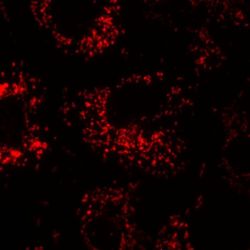
- Experimental details
- Immunocytochemical analysis of COS7 cells stained with Calnexin Monoclonal Antibody (Product # MA3-027). Transfected COS7 cells were blocked in 1% BSA, 5% normal goat serum, and 0.1% Triton X-100 in 1X PBS, and then stained with MA3-027 (1:500), followed by a fluorophore-conjugated goat anti-mouse IgG secondary antibody (red). Magnification = 100X. Data courtesy of the Innovators Program.
- Submitted by
- Invitrogen Antibodies (provider)
- Main image
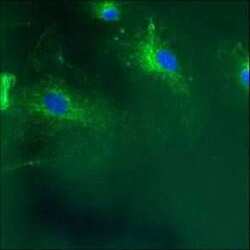
- Experimental details
- Immunofluorescence staining of Calnexin in HMVEC Cells using Product # MA3-027.
- Submitted by
- Invitrogen Antibodies (provider)
- Main image

- Experimental details
- Immunofluorescence staining of Calnexin in A549 Cells using Product # MA3-027.
- Submitted by
- Invitrogen Antibodies (provider)
- Main image

- Experimental details
- Immunofluorescent analysis of calnexin (red) in U87 cells. Cell fixed with 4% paraformaldehyde were permeabilized with 0.05% Triton X-100 in PBS for 60 seconds at room temperature and blocked with 5% normal donkey serum for 30 minutes at room temperature. Cells were probed with a calnexin monoclonal antibody (Product # MA3-027) at a dilution of 1:100 for 2 hours at room temperature, washed with PBS, and incubated with a fluorescently-conjugated goat anti-mouse IgG secondary antibody at a dilution of 1:100 for 45 minutes at room temperature. Nuclei (blue) were stained with DAPI. Images were taken on a fluorescent microscope at 40X magnification. Data courtesy of the Innovators Program.
- Submitted by
- Invitrogen Antibodies (provider)
- Main image
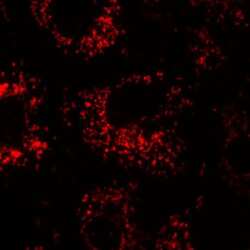
- Experimental details
- Immunocytochemical analysis of COS7 cells stained with Calnexin Monoclonal Antibody (Product # MA3-027). Transfected COS7 cells were blocked in 1% BSA, 5% normal goat serum, and 0.1% Triton X-100 in 1X PBS, and then stained with MA3-027 (1:500), followed by a fluorophore-conjugated goat anti-mouse IgG secondary antibody (red). Magnification = 100X. Data courtesy of the Innovators Program.
- Submitted by
- Invitrogen Antibodies (provider)
- Main image
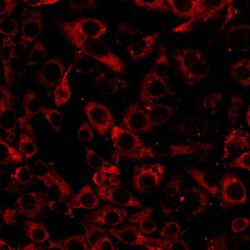
- Experimental details
- Immunofluorescence analysis of Calnexin (red) in MCF7 cells was performed by fixing cells in 4% PFA for 15 min in room temperature. Cells were stained with a Calnexin mouse monoclonal antibody (Product # MA3-027) with a dilution of 1:100 and an incubation overnight at 4C. Confocal imaging was performed using 60X magnification. Data courtesy of Dr Wei Xu's lab at University of Wisconsin Madison.
- Submitted by
- Invitrogen Antibodies (provider)
- Main image
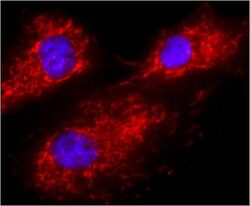
- Experimental details
- Immunofluorescent analysis of calnexin (red) in U87 cells. Cell fixed with 4% paraformaldehyde were permeabilized with 0.05% Triton X-100 in PBS for 60 seconds at room temperature and blocked with 5% normal donkey serum for 30 minutes at room temperature. Cells were probed with a calnexin monoclonal antibody (Product # MA3-027) at a dilution of 1:100 for 2 hours at room temperature, washed with PBS, and incubated with a fluorescently-conjugated goat anti-mouse IgG secondary antibody at a dilution of 1:100 for 45 minutes at room temperature. Nuclei (blue) were stained with DAPI. Images were taken on a fluorescent microscope at 40X magnification. Data courtesy of the Innovators Program.
- Submitted by
- Invitrogen Antibodies (provider)
- Main image
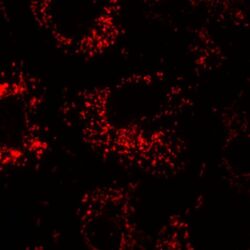
- Experimental details
- Immunocytochemical analysis of COS7 cells stained with Calnexin Monoclonal Antibody (Product # MA3-027). Transfected COS7 cells were blocked in 1% BSA, 5% normal goat serum, and 0.1% Triton X-100 in 1X PBS, and then stained with MA3-027 (1:500), followed by a fluorophore-conjugated goat anti-mouse IgG secondary antibody (red). Magnification = 100X. Data courtesy of the Innovators Program.
- Submitted by
- Invitrogen Antibodies (provider)
- Main image
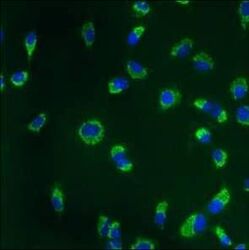
- Experimental details
- Immunofluorescence staining of Calnexin in A549 Cells using Product # MA3-027.
- Submitted by
- Invitrogen Antibodies (provider)
- Main image

- Experimental details
- Immunofluorescence staining of Calnexin in HMVEC Cells using Product # MA3-027.
- Submitted by
- Invitrogen Antibodies (provider)
- Main image
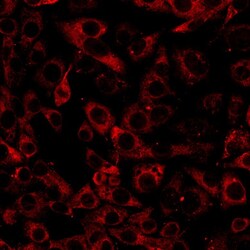
- Experimental details
- Immunofluorescence analysis of Calnexin (red) in MCF7 cells was performed by fixing cells in 4% PFA for 15 min in room temperature. Cells were stained with a Calnexin mouse monoclonal antibody (Product # MA3-027) with a dilution of 1:100 and an incubation overnight at 4C. Confocal imaging was performed using 60X magnification. Data courtesy of Dr Wei Xu's lab at University of Wisconsin Madison.
Supportive validation
- Submitted by
- Invitrogen Antibodies (provider)
- Main image
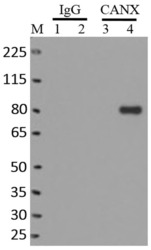
- Experimental details
- Immunoprecipitation of CANX was performed on K562 cells. Antigen-antibody complexes were formed by incubating approximately 500 ug whole cell lysate with 5 ug of monoclonal CANX antibody (Product # MA3-027) rotating 60 min at RT. The immune complexes were captured on 625 ug of Dynabeads M-280 sheep anti-mouse IgG (Product # 11202D), washed extensively, and eluted in NuPAGE LDS sample buffer (Product # NP0007). Samples were resolved onto a 4-12% Bis-Tris protein gel (Product # NP0335BOX). Lanes 1 and 3 are input and lanes 2 and 4 are IP. Proteins were transferred to nitrocellulose membrane (Product # IB23001) and blocked in 5% milk. CANX was detected using a monoclonal CANX antibody (Product # MA3-027) at a dilution of 1:2000, followed by incubation with anti-mouse secondary antibody. Chemiluminescent detection was performed using ECL Western Blotting Substrate (Product # 32106). Data courtesy of the Yeo lab as part of the ENCODE project (www.encodeproject.org).
Supportive validation
- Submitted by
- Invitrogen Antibodies (provider)
- Main image
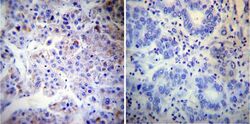
- Experimental details
- Immunohistochemistry was performed on cancer biopsies of deparaffinized Human hepatocarcinoma tissues. To expose target proteins, heat induced antigen retrieval was performed using 10mM sodium citrate (pH6.0) buffer, microwaved for 8-15 minutes. Following antigen retrieval tissues were blocked in 3% BSA-PBS for 30 minutes at room temperature. Tissues were then probed at a dilution of 1:20 with a mouse monoclonal antibody recognizing Anti-Calnexin (Product # MA3-027) or without primary antibody (negative control) overnight at 4°C in a humidified chamber. Tissues were washed extensively with PBST and endogenous peroxidase activity was quenched with a peroxidase suppressor. Detection was performed using a biotin-conjugated secondary antibody and SA-HRP, followed by colorimetric detection using DAB. Tissues were counterstained with hematoxylin and prepped for mounting.
- Submitted by
- Invitrogen Antibodies (provider)
- Main image
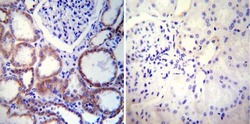
- Experimental details
- Immunohistochemistry was performed on normal deparaffinized Human kidney tissue tissues. To expose target proteins, heat induced antigen retrieval was performed using 10mM sodium citrate (pH6.0) buffer, microwaved for 8-15 minutes. Following antigen retrieval tissues were blocked in 3% BSA-PBS for 30 minutes at room temperature. Tissues were then probed at a dilution of 1:50 with a mouse monoclonal antibody recognizing Anti-Calnexin (Product # MA3-027) or without primary antibody (negative control) overnight at 4°C in a humidified chamber. Tissues were washed extensively with PBST and endogenous peroxidase activity was quenched with a peroxidase suppressor. Detection was performed using a biotin-conjugated secondary antibody and SA-HRP, followed by colorimetric detection using DAB. Tissues were counterstained with hematoxylin and prepped for mounting.
Supportive validation
- Submitted by
- Invitrogen Antibodies (provider)
- Main image
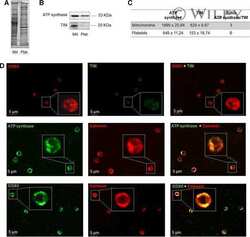
- Experimental details
- NULL
- Submitted by
- Invitrogen Antibodies (provider)
- Main image
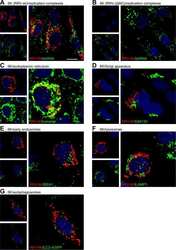
- Experimental details
- NULL
- Submitted by
- Invitrogen Antibodies (provider)
- Main image
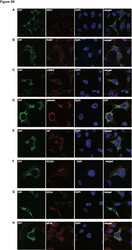
- Experimental details
- NULL
- Submitted by
- Invitrogen Antibodies (provider)
- Main image

- Experimental details
- NULL
- Submitted by
- Invitrogen Antibodies (provider)
- Main image
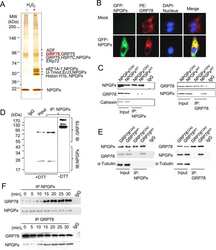
- Experimental details
- NULL
- Submitted by
- Invitrogen Antibodies (provider)
- Main image

- Experimental details
- NULL
- Submitted by
- Invitrogen Antibodies (provider)
- Main image
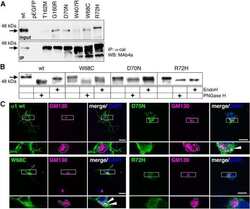
- Experimental details
- NULL
- Submitted by
- Invitrogen Antibodies (provider)
- Main image

- Experimental details
- NULL
- Submitted by
- Invitrogen Antibodies (provider)
- Main image
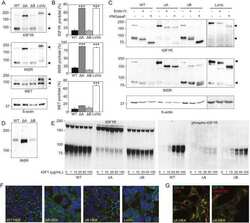
- Experimental details
- NULL
- Submitted by
- Invitrogen Antibodies (provider)
- Main image
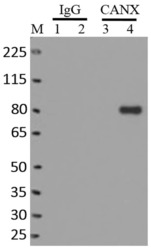
- Experimental details
- Immunoprecipitation of CANX was performed on K562 cells. Antigen-antibody complexes were formed by incubating approximately 500 ug whole cell lysate with 5 ug of monoclonal CANX antibody (Product # MA3-027) rotating 60 min at RT. The immune complexes were captured on 625 ug of Dynabeads M-280 sheep anti-mouse IgG (Product # 11202D), washed extensively, and eluted in NuPAGE LDS sample buffer (Product # NP0007). Samples were resolved onto a 4-12% Bis-Tris protein gel (Product # NP0335BOX). Lanes 1 and 3 are input and lanes 2 and 4 are IP. Proteins were transferred to nitrocellulose membrane (Product # IB23001) and blocked in 5% milk. CANX was detected using a monoclonal CANX antibody (Product # MA3-027) at a dilution of 1:2000, followed by incubation with anti-mouse secondary antibody. Chemiluminescent detection was performed using ECL Western Blotting Substrate (Product # 32106). Data courtesy of the Yeo lab as part of the ENCODE project (www.encodeproject.org).
- Submitted by
- Invitrogen Antibodies (provider)
- Main image
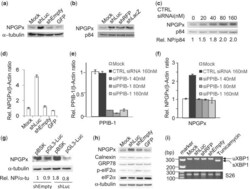
- Experimental details
- Figure 1. NPGPx expression was induced by non-targeting shRNA/RNAi . ( a and b ) Western blot analysis of NPGPx, p84 and alpha-tubulin proteins from WI38 cells infected with lentivirus carrying shLuc, shRFP, shLacZ, GFP, shEmpty (shRNA cloning vector) or uninfected as control. Specific antibodies against each protein were used as probes. p84 and alpha-tubulin served as internal loading controls. ( c ) Western blot analysis of NPGPx protein level in WI38 cells transfected with various amount of non-targeting siRNA (CTRL siRNA). Relative NPGPx/p84 ratio was shown in below. ( d ) NPGPx mRNA expression analyzed by RT-qPCR from WI38 cells infected with lentivirus carrying with shLuc, GFP or control vector (shEmpty) or uninfected as control (mock). Relative NPGPx mRNA level (normalized with beta-actin and compare with Mock) was shown. ( e and f ) RT-qPCR analysis. WI38 cells transfected with non-targeting siRNA (Ctrl siRNA, 160 nM) or PPIB-1 siRNA were used in this assay. The PPIB-1 mRNA amount (e) and NPGPx mRNA expression level (f) were shown. Mock: WI38 cells without siRNA transfection. ( g ) Western blot analysis of WI38 cells infected with vector control (shEmpty) or shLuc, and then transfected with either pBSK or Luciferase expression vector (pGL3-Luc). Cell lysates were harvested 48 h after transfection for western blot analysis. Relative expression ratio of NPGPx/alpha-tubulin (Rel. NP/alpha-tu) was calculated. ( h ) Expressions of stress-related proteins including NPGPx, C
- Submitted by
- Invitrogen Antibodies (provider)
- Main image

- Experimental details
- RNA immunoprecipitation (RIP) western of CANX was performed on K562 cells. Antigen-antibody complexes were formed by incubating approximately 500 µg whole cell lysate with 5 µg of monoclonal CANX antibody (Product # MA3-027) rotating 60 min at RT. The immune complexes were captured on 625 µg of Dynabeads M-280 sheep anti-mouse IgG (Product # 11202D), washed extensively, and eluted in NuPAGE LDS sample buffer (Product # NP0007). Samples were resolved onto a 4-12% Bis-Tris protein gel (Product # NP0335BOX). Lanes 1 and 3 are input and lanes 2 and 4 are IP. Proteins were transferred to nitrocellulose membrane (Product # IB23001) and blocked in 5% milk. CANX was detected using a monoclonal CANX antibody (Product # MA3-027) at a dilution of 1:2000, followed by incubation with anti-mouse secondary antibody. Chemiluminescent detection was performed using ECL Western Blotting Substrate (Product # 32106). Data courtesy of the Yeo lab as part of the ENCODE project (www.encodeproject.org).
- Submitted by
- Invitrogen Antibodies (provider)
- Main image
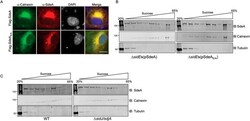
- Experimental details
- Figure 6 The cellular localization of SdeA is not affected by its self-ubiquitination activity. (A) COS-1 cells were transfected to express Flag-SdeA or Flag-SdeA E/A for 24 h. Permeabilized fixed cells were sequentially immunostained with antibodies specific for the ER resident protein calnexin and SdeA; secondary antibodies conjugated to fluorescein and Texas red were used to label calnexin and SdeA, respectively. Note that in both cases, the red fluorescence signals indicative of SdeA co-localized well with those of calnexin. Images were acquired with an Olympus IX-81 fluorescence microscope and were pseudocolored with the IPlab software. Bar, 5 mum. (B) Cellular localization of SdeA or SdeA E/A during bacterial infection. Macrophages infected with L. pneumophila strains expressing SdeA or the SdeA E/A mutant for 2 h were used to determine the cellular localization of translocated SdeA by biochemical fractionation. The ER resident protein calnexin and the cytosolic protein tubulin were used as references. Note that SdeA co-fractionated with calnexin regardless of its ubiquitin ligase activity. Similar results were obtained from three independent experiments. (C) SidJ does not affect the cellular localization of SdeA during bacterial infection. Macrophages infected with wild-type L. pneumophila or a mutant lacking sidJ and sdjA for 2 h were used to determine SdeA distribution in cells by fractionation with sucrose gradient centrifugation. Note that in both samples, SdeA co-
- Submitted by
- Invitrogen Antibodies (provider)
- Main image
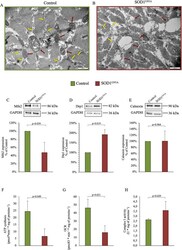
- Experimental details
- Fig. 5 Mitochondrial/ER ultrastructure and bioenergetics activity in skeletal muscles. a , b Electron microscopy representative images of control and SOD1 G93A quadriceps ( n = 3). In both panels, red arrows show mitochondria while yellow arrows show ER ultrastructural profiles. c - e Western blot analysis and relative densitometry quantitative analyses of Mfn2, Drp1, and Calnexin in the two groups. f , g ATP synthesis and oxygen consumption rate stimulated by pyruvate/malate in control (green column) and SOD1 G93A (red column) of isolated mitochondria. h Complex I activity in isolated mitochondria form control (green column) and SOD1 G93A muscles (red column) studied by the FeCN reduction in the presence of NADH. Data are expressed as mean +- SD, n = 3 for each group. Student t test for unpaired data was used for statistical evaluation
- Submitted by
- Invitrogen Antibodies (provider)
- Main image

- Experimental details
- Fig. 1 Generation of PANC-1 cells stably expressing ER-resident and secreted AGR2. a The primary structure of the AGR2 protein shows identified functional domains and motifs. b Expression levels of AGR2 mRNA in PANC-1 stable cell lines were detected by RT-PCR. c Western blotting was used to analyze the presentation of the AGR2 protein in whole cell lysates of PANC-1 stable cell lines. GAPDH served as a loading control. d The presence of AGR2 proteins in cell lysates and culture supernatant was detected by Western blotting. e DSP-stabilized AGR2 in cell lysates and culture supernatant was analyzed under non-reducing (top blot) or reducing conditions (bottom blot). f Cellular distribution of AGR2 and ER-associated protein, calnexin, were determined by immunofluorescence. AGR2 is shown in red, calnexin in green, and Hoechst 33342 in blue. Scale bars: 20 mum
- Submitted by
- Invitrogen Antibodies (provider)
- Main image
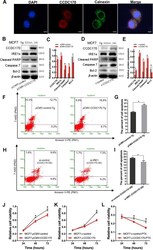
- Experimental details
- Figure 5 CCDC170 promoted cell apoptosis under ER stress. ( A ) IF showed that protein localization of CCDC70 overlapped Calnexin partially. Scale bar: 50mum. ( B, D ) Representative western blot bands of Cleaved PARP, Caspase7, Bcl-2 in MCF7 cells when CCDC170 up-regulated transiently ( C ) and stably ( E ) under TG treatment. pCMV-CCDC170(control) represented CCDC170-transiently-overexpressing MCF7 cells and controls. v-CCDC170(control) represented CCDC170-stably-overexpressing MCF7 cells and controls. beta -actin was used as a reference for calculating the relative protein expression. TG: Thapsigargin (300 nm). ( F ) Representative images of flow cytometry using Annexin V-FITC and PI staining, ( G ) Column bar graph showing an increased proportion of early and late apoptotic cells after CCDC170 overexpression in MCF7 cells treated with TG. 3000 cells were calculated. ( H ) Representative images of flow cytometry using Annexin V-FITC and PI staining, ( I ) Column bar graph showing a decreased proportion of early and late apoptotic cells after IRE1 knockdown in MCF7 cells with CCDC170 overexpression. 3000 cells were calculated. CCDC170 OE : MCF7 cells that transiently overexpressed CCDC170. Detection of cell viability via MTT assay. Transient ( J ) or stable ( K ) overexpression CCDC170, the growth of the cell was suppressed in MCF7 breast cancer cells. ( L ) The cell viability of CCDC170-stably-overexpressing MCF7 cells was significantly lower than that of control cells tre
- Submitted by
- Invitrogen Antibodies (provider)
- Main image

- Experimental details
- Figure 3 Subcellular localization of GFP-tagged wild-type and variant PTCHD1 proteins overexpressed in HEK293T cells. (a) Representative confocal microscopy images of HEK293T cells transfected with GFP, PTCHD1 expression plasmids, GFP-tagged wild-type (WT) or variants of PTCHD1, and stained with anti-GFP antibody (PTCHD1-GFP, green), anti-Na + /K + ATPase antibody (plasma membrane, red), and DAPI (nucleus, blue). n= 3 independent transfections. (b) Manders' coefficient of colocalization calculating the percentage of PTCHD1-GFP WT or variants overlapping Na + /K + ATPase (plasma membrane) staining. Kruskal-Wallis test with Dunn's multiple comparisons tests was made to compare each PTCHD1 variant to the WT. Normality of each condition was measured by the d'Agostino-Pearson normality test. For each condition, n = 7-10 images (each one indicated by one respective dot), from three independent transfections. (c) Representative confocal microscopy images of HEK293T cell lines transfected with GFP, PTCHD1 expression plasmids, GFP-tagged wild-type (WT) or variants of PTCHD1, and stained with anti-GFP antibody (PTCHD1-GFP, green), anti-calnexin antibody (endoplasmic reticulum (ER), red) and DAPI (nucleus, blue). n = 3 independent transfections. (d) Manders' coefficient of colocalization calculating the percentage of Ptchd1-GFP WT or variants overlapping calnexin (ER) staining. For each condition, n = 7-10 images (indicated by one respective dot), from three independent transfections. S
- Submitted by
- Invitrogen Antibodies (provider)
- Main image

- Experimental details
- Figure 1 Expression of AQP2-G215S was decreased in the cell membrane compared with AQP2-WT. MDCK cells were transfected with AQP2-WT and AQP2-G215S plasmids. Total membrane proteins (labeled as T) and cytoplasmic membrane proteins (labeled as C) were harvested for AQP2, Pan-cadherin, and calnexin immunoblotting. Pan-Cadherin is the membrane marker, and calnexin is the endoplasmic marker. Protein fold expression normalized to cadherin is shown. WT, wild type; FK, forskolin. Data were shown as mean +- SEM. n = 3, ** p < 0.01, *** p < 0.001, n.s.=no statistically significant difference.
- Submitted by
- Invitrogen Antibodies (provider)
- Main image
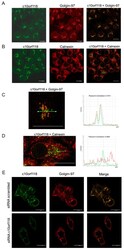
- Experimental details
- Figure 3 Endogenous c10orf118 localizes in the Golgi apparatus in MCF-7 cells. ( A ) Confocal microscopy images of MCF-7 cells stained for c10orf118 (green) and Golgin-97 (red), a Golgi apparatus marker. ( B ) Confocal microscopy images of MCF-7 cells stained for c10orf118 (green) and calnexin (red), a specific endoplasmic reticulum marker. ( C ) Line-scan of the staining performed in the section marked with a green line in the merged view and relative quantification. Overlap of the two signals is apparent. ( D ) Line-scan of the staining in the section marked with a green line in the merged view and relative quantification. ( E ) Confocal microscopy images of MCF-7 cells nucleofected with 30 nmol of scrambled siRNA and siRNA against c10orf118 for 48 h and stained with antibody against c10orf118 (green) or Golgin-97 (red). White bars, 20 um.
- Submitted by
- Invitrogen Antibodies (provider)
- Main image
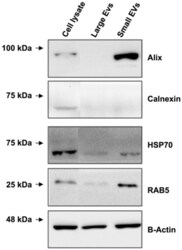
- Experimental details
- Western blot analysis of large extracellular vesicles (EVs), small EVs, and total lysates from C2C12 cell lines (10 mug of protein per lane) to detect the expression of Alix, calnexin, HSP70, and RAB5. Beta-Actin was used as a loading control.
- Submitted by
- Invitrogen Antibodies (provider)
- Main image
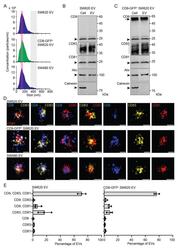
- Experimental details
- Characterization of EVs released by SW620, CD9-GFP + SW620, and SW480 cells. ( A - E ) EVs were recovered from the conditioned media of SW620, CD9-GFP + SW620, and SW480 cells by differential centrifugation, and the resulting 200,000x g pellets were analyzed by the ZetaView particle analyzer ( A ), immunoblotting ( B , C ), and dSTORM ( D , E ). The concentration and size of EVs derived from the indicated cells are shown ( A ). Note the presence of a common population of small particles ( 5000 EVs per experiment). Note that small and large EVs derived from SW480 cells were also quantified ( Supplementary Figure S2 ). Scale bars, 50 nm.
- Submitted by
- Invitrogen Antibodies (provider)
- Main image
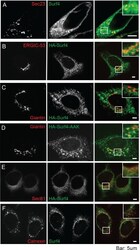
- Experimental details
- Fig 5 Immunofluorescence microscopy of HEK293A cells shows Surf4 accumulates in and around ERESs. (A) Fluorescent signal for endogenous Surf4 (green) was strongest at punctate structures positive for ERES marker Sec23 (red). Note additional Surf4 fluorescence in weblike structures surrounding ERES. (B) HA-Surf4 signal (green) was observed within the ERGIC (ERGIC-53, red). (C) HA-Surf4 (green) showed only low levels of colocalization with cis -Golgi marker, giantin (red). (D) Mutation of proposed COPI recycling motif by replacement of two of three near-carboxy-terminal lysines to alanines (HA-Surf4-AAK, green) increased colocalization with cis -Golgi marker, giantin (red). (E) Newly synthesized HA-Surf4 (green) was found at low levels in the rER (Sec61 marker, red). (F) Surf4 (green) did not colocalize with chaperone, calnexin (red), in the quality control domain. HEK293A cells were transfected with wild-type HA-tagged Surf4 plasmid (B, C, E), or Surf4 KO HEK293A cells were transfected with carboxyl-terminal di-lysine mutation, HA- Surf4 -AAK (D), 18 hr prior to fixation. Bars = 5mum. The cells in each panel are shown 3 times, first with organelle marker, then Surf4 and final panel (with magnified insert) showing overlap. Alexa Fluor secondary antibodies were used for detection. Images were obtained using an LSM 780 (Carl Zeiss) confocal microscope (488 and 561 nm excitation lines; 500-560 and 600-660 nm capture) and Zeiss Axio Imager Z1 with Apotome 2 (single Z stack slice).
- Submitted by
- Invitrogen Antibodies (provider)
- Main image
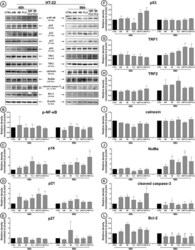
- Experimental details
- Fig. 4 Antidepressants-mediated effect on cellular protein content. HT-22 cells were treated with antidepressants for 48 and 96 h and densitometry analysis of NF-kappaB ( b ), p16 ( c ), p21 ( d ), p27 ( e ), p53 ( f ), TRF1 ( g ), TRF2 ( h ), calnexin ( i ), NuMa ( j ), cleaved caspase 3 ( k ), Bcl-2 ( l ) was evaluated. Representative Western Blots are presented ( a ). Bars indicate SD, n = 3, *** /^^^ p < 0.001, ** /^^ p < 0.01, * /^ p < 0.05, no indication--no statistical significance (one-way ANOVA and Dunnett's a posteriori test)
 Explore
Explore Validate
Validate Learn
Learn Western blot
Western blot Immunocytochemistry
Immunocytochemistry